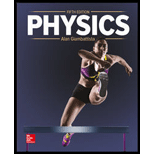
Concept explainers
The description of the
Answer to Problem 1CQ
Photoelectric effect is the phenomenon in which the electrons are ejected from metals when light of certain frequency is incident on them. Photon model of light explained the experimental results of the effect using the quantum nature of light.
Explanation of Solution
Photoelectric effect is the phenomenon in which the electrons are ejected from the surface of a metal when
The second characteristic that could not be explained by classical theory was that maximum kinetic energy of the electrons depends on the wavelength of the incident radiation. This can be explained as shorter wavelength radiation has higher energy and this will provide more kinetic energy to the ejected electrons. The third characteristic is that photoelectric effect will not occur below a threshold frequency of the incident radiation. This can be understood as certain minimum amount of energy is required to free the electrons from the material to which they are bound. The final characteristic that puzzled the nineteenth century scientists was that the electrons are emitted virtually instantaneously after turning on a photon source. This is explained as each individual electron carries enough energy to cause the photoelectron to be emitted. Since only a single photon is required to eject an electron, the process happens instantaneously.
Conclusion:
Thus, the photoelectric effect is the phenomenon in which the electrons are ejected from metals when light of certain frequency is incident on them. Photon model of light explained the experimental results of the effect using the quantum nature of light.
Want to see more full solutions like this?
Chapter 27 Solutions
Physics
- What is meant by photo electricity? Describe the main features of photoelectric emission. Give an expression for the kinetic energy of the photoelectrons emitted from a surface, explaining what is meant by workfunction, the threshold frequency (or cut-offfrequency) and Planck's constant.arrow_forwardHow does the quantum theory of light explain phenomena like the photoelectric effect?arrow_forwardHow does Photon work in medicine? List 6 uses of LASER. What are fiber optics? How is this used in medicine? Aside from medicine, where else are fiber optics used? Where are the following optics used? a. Side Emitting Fiber Optics b. Tip Illuminated Fiber Optics c. Fiber Optic Light Pipes How does light travel? How does a prism split white light into a spectrum? How can we produce Magenta, cyan, and yellow? How does a pinhole camera work?arrow_forward
- How does the photoelectric effect explain the mechanism of detection of UV and visible light in a phototube or photomultiplier tube? Explain (specifically but briefly) why a phototube or photomultiplier tube cannot be used to detect IR or microwave radiationarrow_forwardDescribe the photoelectric effect and its application in astronomy and solar panels. Please include links/references.arrow_forwardDescribe the ultraviolet catastrophe and how it shaped scientists’ understanding of light.arrow_forward
- You learned how light and matter interact. Matter can transmit, absorb, and reflect light. Visible light includes a range of colors and is the only part of the electromagnetic spectrum that we can see. Read the scenario about light and answer the questions in complete sentences. You have a blue backpack and you look at it through blue glass. What color would the backpack appear to be? Suppose you took the same blue backpack and looked at it through red glass, what color would the backpack appear to be? Explain your answers.arrow_forwardshortly explain the photoelectric effect. How did it change the view of light at the time? How do we view light now?arrow_forwardImagine a photon that was determined to have a wavelength of 150 nm. Remembering that the speed of light is 3*10^8 m/s, what is the frequency of that light in units of Hz? (Provide only the number with commas to help count off orders of ten accurately, do not use scientific notation)arrow_forward
- Define the threshold wavelength in the photoelectric effect?arrow_forwardIf the wavelength of a photon is doubled, describe what happens to its energy. How would you describe the frequency of such light?arrow_forwardIn your own words, describe the photoelectric effect and its application in astronomy and solar panels.arrow_forward
